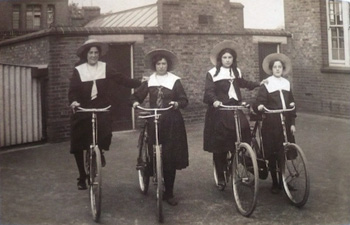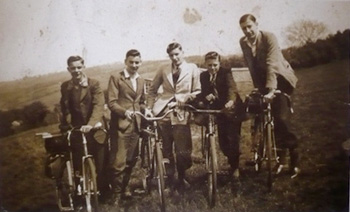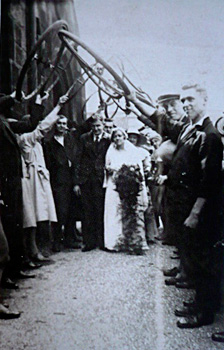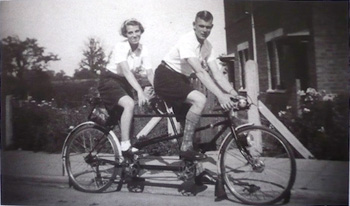
..........................................................................................................................................................................................................
bicycles: vintage people on photo postcards. tom phillips. foreword by william fotheringham. bodleian library. hardback 112pp illus. £15 ($25)

'you could now go to one of the studios springing up all over the country, pose for your picture, examine the result after a short interval and, approving it, have it replicated for not much more than a penny a card.'
we are, i believe, becoming obsessed with the photograph. i make the distinction between the end result and the art or process of achieving it, for not only do i believe there to be a distinction, but many contemporary photographs rather underline my being correct in this assumption. i refer not to the consummate output of the professional, but the scatter-gun approach of those armed either with a cheap digital camera or, more likely, the same device embedded in what started life as a mobile phone. it is of little wonder that such is the case; a currently airing advert from nokia makes it plain just how much import is being placed on this aspect of the smartphone. so much so, that the advertisement fails to mention that it is possible to make phone calls with the device.
in the late nineties i read widely of the necessity in producing websites that adhered, if only loosely, to some sort of useability guidelines. the principal progenitor of such guidelines was one jakob neilsen, through the auspices of his website useit.com, a site he still occupies to this day, though by contemporary comparison it appears to be still stuck in the late nineties. however, bearing in mind all that i think i learned from these studies, facebook to me seems like a complete mess; i cannot understand why anyone is remotely interested in having a facebook page, nor do i understand why it has to look like a dog's dinner. however, i am willing to admit that this likely says more about me than about facebook or those who inhabit such a world. however, what cannot be denied is that facebook has almost singlehandedly popularised the notion of photographically recording every triviality of millions of lives, predominantly via the ubiquitous mobile phone. why anyone thinks that pictures of how drunk they were last weekend is of interest to normal citizens is undoubtedly one of those answers on a postcard type questions.

the editor of our local newspaper works on the theory that photographs are often of more efficacy than the written word, adhering to the premise that a picture is worth a thousand words. we do slightly differ over this interpretation, but mostly because i favour the written word, and cheerfully read many a text devoid of illustration. however, given the apparent lessening of attention span in this internet information age, perhaps he has a point. therefore it is hard to argue against his interpretation of modern media.
in the latter part of the 19th century and up till the late 1950s, photography remained the province of either the professional or the serious amateur, if for no other reason than cameras were considered too expensive for the proletariat. this meant that the majority of photographs from both centuries had a formality and skill that is all too evidently missing from the facebook generation. interestingly, photos posted on flickr tend to be of higher quality, but that perhaps has much to do with the difference in intent. it is possible that the iphone crowd are inadvertantly documenting the 21st century, but almost definitely not intentionally. however it is also true that the majority of photographers from the early to mid 20th century were not necessarily conscious of fulfilling the same function; it is simply with hindsight that we have imposed this upon them. either way, we have cause to be thankful that so many offered their photographic services to a by and large, accepting public.

the second point for which we must be thankful is that a substantial percentage of the cycling public, or perhaps simply those who were proud of their velocipedes, indulged in mass narcissism, visiting many a professional studio photographer to have them portray self and bicycle in front of an array of the most improbable backgrounds ever assembled. one chap is even seen standing in front of incoming tidal waves. the fact that so many were pre-disposed to pose in their sunday best, apparently using the bicycle as little more than a prop, is perhaps worthy of investigation in and of itself. surely a major social phenomenon?
author tom phillips, of whom i know precious little, has acquired a comprehensive collection of these black and white postcards and is thus finely placed to elucidate further on this phenomenon. 'to have a portrait made and to possess your own likeness was, for centuries, a luxury that only landed gentry or the mercantile rich could afford. photography changed all that. yet a a radical democratisation of portraiture had to wait until 1902 when the post office finally allowed messages as well as addresses to appear on the backs of the regulation-sized cards that cost only a halfpenny to post.'
the book is part of a series of books published by the bodleian library, portraying readers, women and hats and weddings and is a fascinating insight not only into the recent past, but a bit of an eye-opener as to the bicycles that form a major part of each postcard. nowadays the sort of bicycle owned by the average civilian would be perceived as something of an embarrassment by most readers of the post; surely no-one with less than the highest tech carbon fibre would dare to be photographed with said machine, personally bedecked in their sunday ride finery? yet with one or two exceptions, the machines pictured with their riders would not disgrace a modern day pashley cycles catalogue, looking far more substantial and regal than anything sterling house could offer.

it is a sign of the times that the age of the personalised postcard has pretty much disappeared from view, leaving future historians to leaf through an archive of facebook pages, wondering how it was that a digital, auto-focus camera could produce pictures of such dubious quality. i would imagine that far more contemporary photographs remain as a series of zeros and ones than make it to printed matter. as phillips recalls "early in the century, the hobby of collecting commercial picture postcards was already well established. every household boasted an album full of views of places visited, celebrities admired etc. exchange of such cards became a social ritual."
he is also aware of the modern pixelated phenomenon to which i have already referred; "photographic portraiture has come full circle: a formal studio portrait is once more a luxury item. now that our phone, or even toothbrush, can record a more than passable image, we are refracted in a kaleidoscope of likenesses."
the fascination of any image is the story that brought it to our attention, but unlike moving pictures, the photograph is a moment frozen in time. some advertise the circumstances that led to that moment in time, and even presage the events that followed. to an extent, that is the premise of the news photo editor, choosing an image that might reduce the number of words required to accompany.

however, leaving aside for a moment, the studio photos illustrated in the book's 112 pages, those featuring riders in more humble settings invite inquisitiveness. who are the occupants; where were they from; where were they going; whatever happened to them; what brought them to the bicycle? one particular photo of a young couple on a tandem, both in white shirts and black shorts, he with straight face, long socks and serious haircut, she with cheery smile, ankle socks and hairband, made a lasting impression for no perceivable reason. there is no information as to the date or the location, but i really want to know who they were. there's a large saddlebag behind the stoker, so perhaps they were off for some light touring. perhaps they intended simply a day in the saddles, taking provisions enough for lunch in the countryside. i'll likely never know, and to be honest, that's probably what drew me back to this image several times.
call me nostalgic if you wish; i am happy with the description, and feel a similar premise inhabits the forthcoming tweed run for the very same reasons. with the endless supply of taiwanese carbon fibre continuously on offer and the less than endearing ubiquity of the motor car in this so-called modern world, it is unmitigated joy to leaf through the pages of vintage people on bicycles, an experience that i'm sure would prove as endearing to you as it was to me. it is an education to see from whence we came and where, if there is any justice in the world (doubtful) we might return.
in defence of the written word and the grammatical punctuation of same, it gave great pleasure to read tom phillips' few words of enjoining text, for he employs punctuation in the same manner taught in my english class. it's all different nowadays, and rarely the better for it.
all illustrations copyright tom phillips collection
posted wednesday 16th march 2011
 ..........................................................................................................................................................................................................
..........................................................................................................................................................................................................